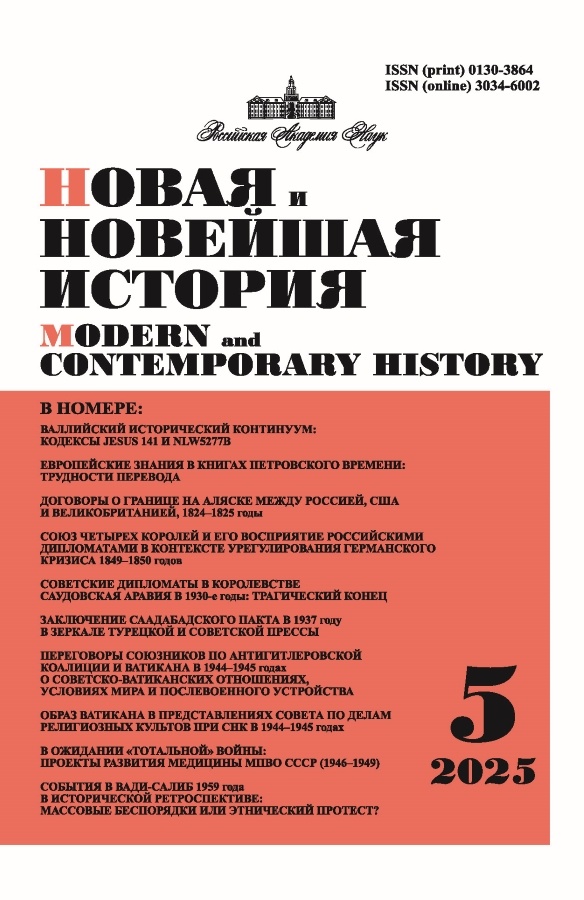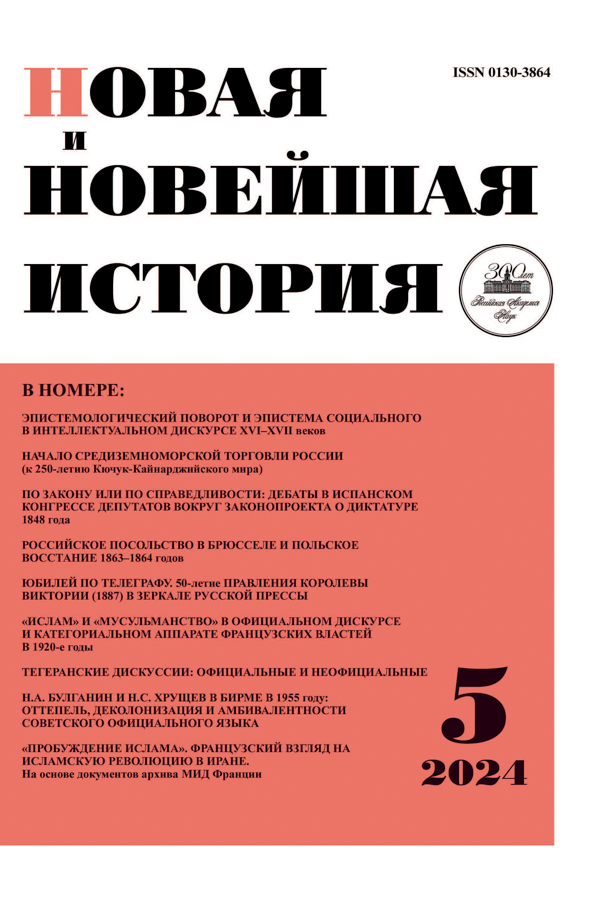«Социальная» терминология в лексикографии De verborum significatione Джона Скина
- Авторы: Паламарчук А.А.1
-
Учреждения:
- Санкт-Петербургский государственный университет
- Выпуск: № 5 (2024)
- Страницы: 18-24
- Раздел: Новое время
- URL: https://snv63.ru/0130-3864/article/view/671533
- DOI: https://doi.org/10.31857/S0130386424050027
- ID: 671533
Цитировать
Полный текст
Аннотация
Процесс спецификации социального и, в частности, размежевания собственно социального от правового в интеллектуальном дискурсе раннего Нового времени имел как общие закономерности, так и элементы, определявшиеся региональной спецификой интеллектуальной традиции и институциональных практик. В статье рассматривается шотландский вариант данного процесса на примере лексикографии шотландского юриста-цивилиста сэра Джона Скина (1549–1617) De verborum significatione. Анализ репертуара социальных понятий в лексикографии показал, что известная современникам неоднородность генезиса страт и групп внутри шотландской знати не позволяла выстроить иерархию знатных титулов и достоинств шотландского королевства, а следовательно, препятствовала рефлексии о знати как о социальном явлении. Вместе с тем доминирование принципов цивильного права с его четко определенной предметной областью и устойчивым терминологическим аппаратом стимулировало спецификацию сферы правового, но в дальнейшем препятствовало размежеванию правового и социального. В статье показано, что многие термины, которые впоследствии приобретут собственно социальные интерпретации в шотландской интеллектуальной традиции, в начале XVII столетия продолжали трактоваться как интегральная часть системы правовых взаимодействий в общине королевства, а их упоминания в исследуемых Скином шотландских законах и парламентских актах связаны с правовыми привилегиями, судебной процедурой или спецификой владельческих отношений. Востребованность среди шотландских интеллектуалов кальвинистской антииерархической теологии коллективного завета объяснялась отсутствием к XVI столетию возможности выстроить в масштабах королевства единую и иерархически организованную структуру общины с использованием общего для всех ее компонентов правового или «социального» параметра.
Ключевые слова
Полный текст
Об авторах
Анастасия Андреевна Паламарчук
Санкт-Петербургский государственный университет
Автор, ответственный за переписку.
Email: sir.hnry.finch@gmail.com
ORCID iD: 0000-0002-0851-6875
Scopus Author ID: 57201724636
ResearcherId: J-5315-2013
доктор исторических наук, научный сотрудник
Россия, Санкт-ПетербургСписок литературы
- Паламарчук А.А. Рождение социальной терминологии в раннестюартовской антикварной традиции // Электронный научно-образовательный журнал «История». 2022. T. 13. Вып. 6 (116). URL: https://history.jes.su/s207987840021758-2-1/ (дата обращения: 25.07.2024). doi: 10.18254/S207987840021758-2
- Федоров С.Е. Дискуссия об истинном благородстве и социальные классификации знати в антикварных текстах раннего нового времени // Вестник СПбГУ. История. 2023. Т. 68. № 3. С. 712–727.
- Хоменкова В.Ю. Сэр Джон Ферн и формирование антикварного нарратива о Nobilitas // Средние века. 2023. Т. 84. № 3. С. 198–215.
- Fyodorov S.Ye. Diskussija ob istinnom blagorodstve i social’nye klassifikacii znati v antikvarnyh tekstah rannego novogo vremeni [Debate on the True Nobility and Social Classifications of the Nobility in the Early Modern Antiquarian Corpora] // Vestnik SPbGU. Istoria [Vestnik of St.Petersburg State University. History]. 2023. T. 68. № 3. S. 712–727. (In Russ.) (In Russ.)
- Khomenkova V. Iu. Sir John Fern i formirovanie antikvarnogo narrativa o Nobilitas [Sir John Fern and Formation of Antiquarian Narrative on Nobilitas] // Srednie veka [The Middle Ages]. 2023. Vol. 84. № 3. S. 198–215. (In Russ.)
- Palamarchuk A.A. Rozhdenie social’noj terminologii v rannestjuartovskoj antikvarnoj tradicii [The Birth of Social Terminology in the Early Stuart Antique Tradition] // Elektronnyj nauchno-obrazovatel’nyj zhurnal “Istoriya” [Electronic scientific and educational Journal “History”]. 2022. T. 13. Vyp. 6 (116). URL: https://history.jes.su/s207987840021758-2-1/ (access date: 25.07.2024). doi: 10.18254/S207987840021758-2 (In Russ.)
- Ashgate Critical Essays on early English Lexicographies. Vol. 4. The Seventeenth century / ed. J. Cosindine. Farnham, 2012.
- Barrow G.W.S. The Kingdom of the Scots: Government, Church and Society from the eleventh to the fourteenth century. New York, 1973.
- Brown K. Noble Society in Scotland: Wealth, Family and Culture, from Reformation to Revolution. Edinburgh, 2004.
- Cosindine J. Sixteenth-Century English Dictionaries. Oxford, 2022.
- Cowell J. The Interpreter: or Booke Containing the Signification of Words... as Are Mentioned in the Lawe Writers. Cambridge, 1607.
- Craig Th. Thomae Craigi de Riccarton Jus Feudale. Lipsiae, 1716. P. 140.
- Donaldson R. A Mixed Edition of “De verborum significatione” // The Bibliotheck: A Scottish Journal of Bibliography and Allied Topics. 1962. Vol. 3. № 6. P. 219–220.
- Elazar D.J. Covenant and Commonwealth. From Christian separation through the Protestant Reformation. The Covenant Tradition in Politics. Vol. 2. New Brunswick; London. 1996. P. 132–137.
- Grant A. Franchise North of the Border // Liberties and Identities in the Medieval British Isles / ed. M. Prestwich. Woodbridge, 2008. P. 155–199.
- Kelley D.R. De Origine Feudorum: The Beginnings of an Historical Problem // Speculum. 1964. Vol. 39. № 2. P. 207–228.
- Lancashire J., Damianopoulos J. The early Modern Englaish Law Lexicon // Legal Lexicography. A comparative perspective / ed. M. MacAodha. Farnham, 2014. P. 30–44.
- Legal Lexicography: A Comparative Perspective / ed. M. Aodha. London; New York, 2016.
- Levack B.P. The Formation of the British State: England, Scotland and the Union of Crowns 1603–1707. Oxford, 1987. P. 88–91.
- MacQueen H.L. Law and Legal Consciousness in medieval Scotland. Leiden, 2024.
- Rastell J. Exposiciones termino rum legum anglorum. Et natura breuium cum diuersibus casubus regulis et fundamentis legum tam de libris Magistri Litteltoni quam de aliis legum libris Imprynted at London, 1523.
- Regiam Majestatem Scotiae Veteres Leges et Constitutiones, Ex Archivis Publicis, Et Antiquis Libris Manuscriptis Collectae, Recognitae, Et Notis Juris Civilis, Canonici, Nortmannici Auctoritate Confirmatis, Illustratae, Opera & Studio Joannis Skenaei, Regiae Majestati a Conciliis & Archivis Publicis. Annotantur in Margine, Concordantiae Juris Divini, Legum Angliae, Et Juris Novissimi Scotiae quod Acta Parliamenti, Vulgo, Vocant. Catalogum Eorum quae in his Libris Continentur Vicesima Pagina, Indicat. Cum Duplici Indice, Altero Rerum, Altero Verborum Locupletissimo. Edinburgh, 1609.
- Skene J. De Verborum Significatione: The Exposition of the Termes and Difficill Wordes, Conteined in the Foure Buikes of Regiam Majestatem, and Uthers, In the Acts of Parliament, Infestments; And Used in Practique of this Realme. Edinburgh, 1597.
- Taylor A. Homo Ligius and unfreedom in Medieval Scotland, 1093–1286 // New Perspectives on Medieval Scotland / ed. M. Hammond. Woodbridge, 2013. P. 85–116.
- The lavves and acts of Parliament, maid be King Iames the First, and his royal successours kinges of Scotland. Edinburgh, 1597.
Дополнительные файлы











